

Table of contents
- Terms hardiness and periwinkle
- Cherry laurel (Prunus laurocerasus)
- Occidental tree of life (Thuja occidentalis)
- Yew (Taxus baccata)
- False cypress (Chamaecyparis lawsoniana)
- Evergreen holly (Ilex aquifolium)
- Privet (Ligustrum vulgare)
- Boxwood (Buxus sempervirens)
- Photinia x fraseri
In order for a hedge in the garden to remain dense and green, it is necessary to choose the right plants for it. In addition to the basic requirements for winter hardiness and year-round green foliage, it is above all It is important that the shrubs are well tolerated by pruning and, depending on requirements, more or less quickly grow.
Terms hardiness and periwinkle
Plants are referred to as evergreen if they do not shed their leaves over a large area in autumn or at other times of the year. The renewal of the foliage takes place in an ongoing, hardly noticeable process, so that there is always old and new foliage on the plant during the growing season. In comparison, wintergreen plants completely renew their foliage in the spring, so they are bare for some time. Plants that are hardy can cope well with deep frost. The structure of the leaves, stems and, above all, plant sap allows it to survive the winter without damage. While frost hardiness refers to plants in their natural environment, hardiness also characterizes imported garden plants.
Cherry laurel (Prunus laurocerasus)

This shrub originally comes from Asia Minor, but has now adapted so well to our climate that it not only hardy, but also self-seeds if not cared for and thus develop into a real weed can. However, with regularly trimmed hedges, this risk is low. The plants are particularly suitable for larger hedges as they can reach a height of up to 4 m. The evergreen leaves are reminiscent of laurel, the small drupes of cherries, which explains the name. Some parts of the plant are poisonous.
claims and care
- soil condition: all normal garden soils suitable, no special requirements
- Pour: in dry summers and winters
- Fertilize: in spring with new growth with compost
- Cut: tolerates pruning well, in spring
- Diseases: Fungal infestation possible, treat with fungicide if necessary
- planting distance: depending on variety and size 1 - 3 plants per meter
Occidental tree of life (Thuja occidentalis)

The wild form of this cypress species is native to North America, where it can reach heights of growth of up to 20 m as a tree. Cultivated forms for gardens remain significantly lower, so that they can also be planted as hedges. The evergreen foliage makes them opaque. The plant is poisonous due to the essential oils it contains.
claims and care
- soil condition: Prefers moist, tolerates dry, calcareous, sandy, loamy soil
- Location: sunny to semi-shady
- Pour: keep moist in the first few years, later when it is very dry, mulching makes sense
- Fertilize: in spring with compost
- Cut: regularly necessary for dense hedges, June and August, avoid excessive pruning
- Diseases: especially fungal diseases, possibly treat with fungicide
- planting distance: between 2 and 3 plants per meter
Yew (Taxus baccata)
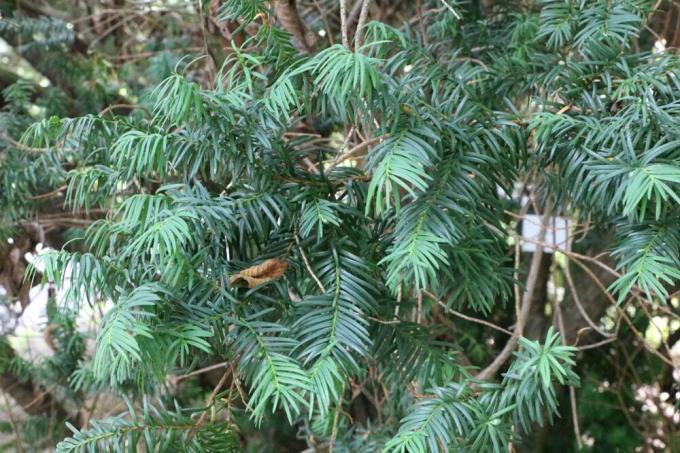
This native conifer is very popular as a hedge plant because it is not only evergreen and hardy, but also very durable. The wild species is also used most frequently in gardens because it is robust and inexpensive. The yew can be used both for low fences and for larger hedges, more or less strong-growing plants are used accordingly. Be careful with children in the household, yews are highly poisonous and their red fruits can tempt you to eat them.
claims and care
- soil condition: loamy, nutritious, calcareous, not too dry
- Location: shady or sunny, no special requirements
- Pour: Do not let the soil dry out, especially in the year of planting, later when it is dry
- Fertilize: directly when planting and later in the spring with compost
- Cut: slow growing, regular pruning once a year in spring for dense growth
- Diseases: Hardly susceptible, possibly fungal attack
- planting distance: slow-growing up to 5 plants per meter, fast-growing 3 plants
False cypress (Chamaecyparis lawsoniana)

Similar to the tree of life, the wild forms of the false cypress come from North America or Asia. Most species grow as pyramid shaped trees or less commonly as shrubs. As a free tree, a height of up to 55 m can be reached. All parts of the plant are poisonous, consumption leads to nausea and vomiting, this also applies to pets. In the garden, the conifer grows very well and has a dense, opaque growth with appropriate pruning.
claims and care
- soil condition: slightly acidic, moist without waterlogging
- Location: Sunny preferred, stunted growth and bare if there is too much shade
- Pour: keep freshly planted moist, later only in severe drought
- Fertilize: in spring and autumn
- Cut: in the spring, do not cut back into the old wood, otherwise there will be no new growth
- Diseases: Treat fungal diseases with fungicide, cut back on pests
- planting distance: between 30 to 50 cm between plants
Evergreen holly (Ilex aquifolium)
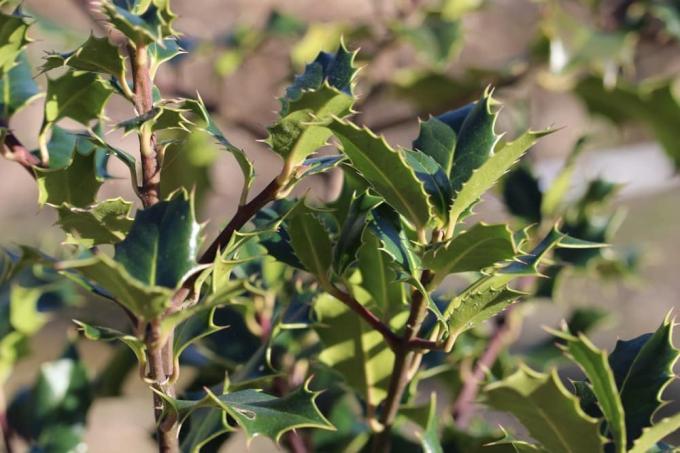
The holly tree is mainly known as a Christmas decoration. Since the berries are very noticeable in winter with their bright red, they are also called winter berries. The dark green leaves are characteristic, with a leathery sheen and thorny teeth on the sides. The holly is distributed worldwide and is also native to our latitudes. Therefore, winter hardiness is not a problem for them. As with the yew, caution is advised with children. The plant is poisonous, including the berries. As a free tree, holly can grow several meters tall, but it is just as suitable as a small hedge plant.
claims and care
- soil condition: moist, nutritious, slightly acidic, no calcareous loamy soil
- Location: bright but not full sun, shade is tolerated
- Pour: only when it is very dry
- Fertilize: in spring with leaf compost or rhododendron fertilizer, bark mulch makes sense
- Pruning: tolerates pruning into mature wood, early spring or early summer
- Diseases: Frequently dispose of Ilex leafminers, infested leaves and shoots
- planting distance: Depending on the species and size, 2 to 6 plants per meter
- Winter protection: protect sensitive varieties with fleece
Privet (Ligustrum vulgare)
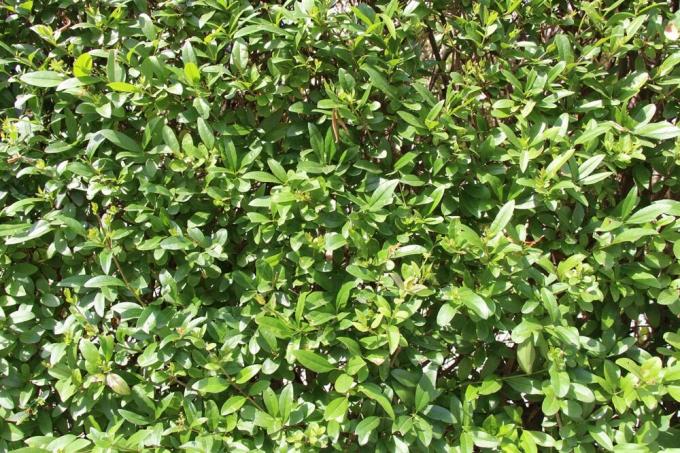
Among the privet plants there are both deciduous and evergreen varieties. The common privet is native to Europe and is known by many different names. Among them are willow and dogwood. With mild winters, the old foliage is gradually shed in the spring when new growth occurs. In harder winters it can happen that the leaves are shed earlier. Leaves and fruits of the plant are poisonous. Even contact with the plant sap when pruning can lead to skin irritation.
Tip:
Privet is well suited for natural hedges as it is a favorite spot for birds and insects.
claims and care
- soil condition: dry to moderately moist, sandy to loamy
- Location: prefers sunny, tolerates shady
- Pour: tolerates drought, survives longer periods without water
- Fertilize: when planting and in spring with compost, mulching makes sense
- Cut: with strong growth twice a year, in early summer and at the end of August, pruning into the old wood is possible for regeneration
- Diseases: quite robust, fungal diseases or pests possible
- planting distance: 4 to 5 plants per meter
Boxwood (Buxus sempervirens)
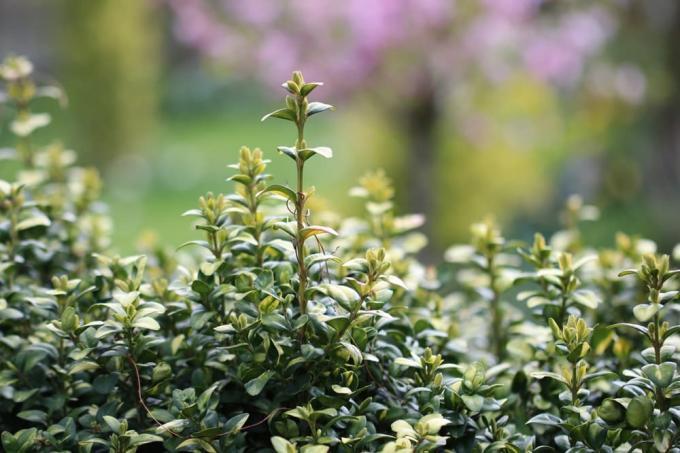
The common boxwood is native to Central Europe. However, there are other types of boxwood worldwide, especially in the northern hemisphere. When growing freely, the ordinary boxwood can grow up to 6 m tall. The dense branching and good pruning tolerance are characteristic of the plant. Buchs can be cut into any imaginable shape and is cut back one to five times a year. The boxwood is also poisonous in all parts of the plant.
claims and care
- soil condition: permeable, no waterlogging, otherwise undemanding
- Location: sheltered, not in full sun, shade preferred
- Pour: tolerates greater drought, but water sensibly
- Fertilize: in spring compost or special boxwood fertilizer
- Cut: very tolerant of pruning, the more often it is pruned, the denser it grows
- Diseases: Fungal diseases and box tree moths lead to shoot death
- planting distance: 10 pieces per meter for small hedges, 5 to 6 for large ones
- Winter protection: protect from strong sunlight
Photinia x fraseri

This evergreen tree belongs to the rose family. Most species are native to North America or South or South America. native to East Asia. The bronze-red leaf shoots are particularly attractive. The shrub can reach a height of up to 3 m. Breeding varieties remain somewhat lower. In old age, the photinia grows, especially in width. The red fruits, which are formed in autumn, are often eaten by birds. In humans, eating the berries can lead to symptoms of poisoning, even if other parts of the plant do not contain any poison. Particular caution is required with children.
claims and care
- soil condition: rich in nutrients, moderately dry, well-drained, no waterlogging
- Location: protected, sunny to semi-shady
- Pour: regularly in the beginning
- Fertilize: in spring with compost
- Cut: after flowering in spring
- Diseases: Fungal diseases or pest infestation possible, can be eliminated by pruning
- planting distance: 2 to 3 plants per meter
- Winter protection: partially frost-sensitive varieties
Tip:
The 'Robusta' variety tolerates frost best.
 Home editorial office
Home editorial office
Learn more about hedges

Rocket juniper, Juniperus scopulorum: care tips
The rocket juniper (Juniperus scopulorum) is also known as columnar juniper and can reach impressive heights. Here we show how it can be cultivated successfully. There are also some care tips that can strengthen growth and the plant.

Conifers turn brown | reasons and solutions
Conifers are used in the garden as a hedge, group or solitary. Smaller specimens of the conifers decorate the balcony or terrace in the tub. If they turn brown, you should investigate the cause, because this behavior is usually not normal.

24 easy-care hedges – privacy without work
Hedges protect more or less well from prying eyes and are a good alternative to conventional fences. However, it is not always easy to find the right plants, especially when you want them to be as easy to care for as possible.
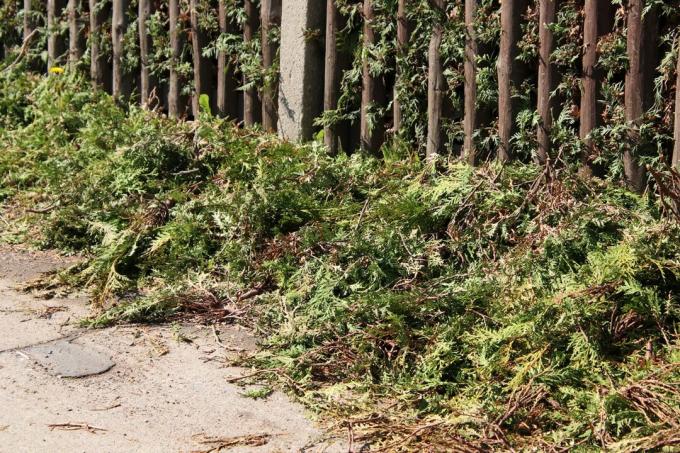
Pruning conifers: when is the best time?
Pruning conifers is easily possible with the right knowledge. But when is the best time for the measure and when is cutting allowed? Here is the most important information about cutting the coniferous hedge.

Fertilize thuja hedges: 7 effective fertilizers
Because of its dense growth, the Thuja is particularly valued as a hedge. In order for the growth to actually take place densely and without gaps, the plant needs sufficient nutrients. We explain how you should fertilize the tree of life for lush growth.

How fast do yews grow? | Yew hedge growth
The yew (bot. Taxus) is not without reason a popular garden and hedge plant, because it is an evergreen plant and can be easily cut into different shapes. Their growth depends on location and care.



